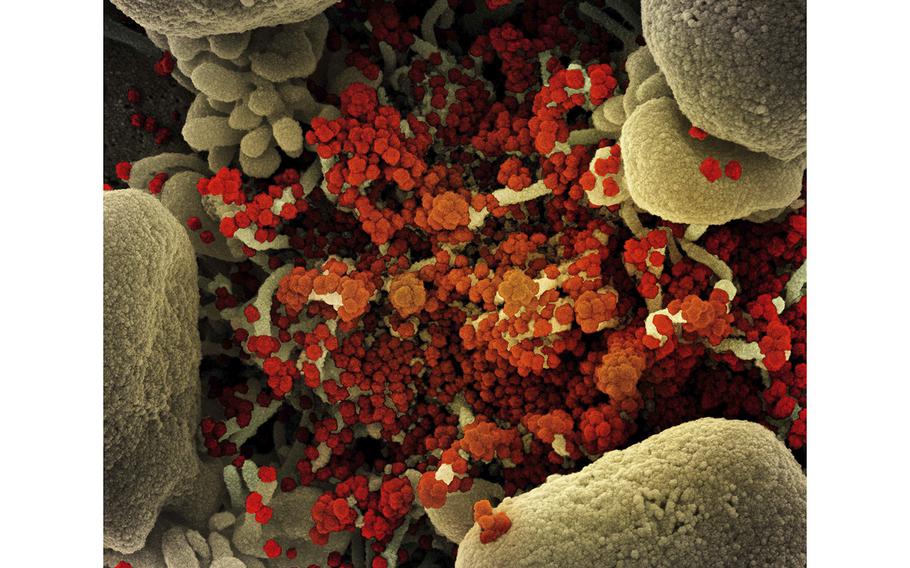
Colorized scanning electron micrograph of a cell heavily infected with SARS-CoV-2 virus particles (orange/red), isolated from a patient sample. World Health Organization officials expressed concern Wednesday about a new omicron subvariant of the coronavirus — its most transmissible yet. (NIAID via ZUMA Wire/TNS)
Stars and Stripes is making stories on the coronavirus pandemic available free of charge. See more stories here. Sign up for our daily coronavirus newsletter here. Please support our journalism with a subscription.
World Health Organization officials expressed concern Wednesday about a new omicron subvariant of the coronavirus — its most transmissible yet — while also urging China to be more forthcoming with its data on infections and deaths amid a recent surge there.
The XBB.1.5 subvariant, which has been circulating since at least October and is known to have spread to 29 countries, is the most transmissible version of the omicron variant detected by health officials so far, said Maria Van Kerkhove, the technical leader for the organization's covid response. However, she added that there was no indication yet that XBB.1.5 caused more severe illness than omicron's other subvariants.
Declining global surveillance of the coronavirus, incomplete data from China and an increase in COVID-19 deaths worldwide are concerning, she said at a news conference. "It is not just a matter of knowing what variants are circulating. We need the global community to assess these, to look at mutation by mutation to determine if any of these are new variants that are circulating."
Mike Ryan, executive director of the WHO's health emergencies program, who spoke at the same news conference, said he met with Chinese health officials last week and reiterated concerns about China's data, including its definition of a COVID-19 death, which he said he viewed as too narrow.
The Associated Press reported last month that only COVID-19 deaths from pneumonia or respiratory failure were counted in China's official tallies. Chinese authorities have also stopped tracking asymptomatic cases, according to previous reporting from The Washington Post.
The newly tightened criteria for what China considers a COVID-related death have frustrated health officials abroad trying to prepare for potential mutations from major outbreaks. It has also increased suspicion that the official death toll and number of infections in the world's most populous country represent a significant undercount.
China has had at least 120,000 new weekly cases or more in December, according to the WHO. The number of weekly deaths has ranged between 240 and 440 during that period, according to those figures, despite reports of overflowing hospital wards, funeral homes and crematoriums.
Ryan said the organization believes the numbers China is publishing "underrepresent the true impact of the disease in terms of hospital admissions, in terms of ICU admissions and particularly in terms of deaths."
Tedros Adhanom Ghebreyesus, the WHO's director general, also urged Chinese officials Wednesday to provide "more rapid, regular, reliable data on hospitalizations" and "more comprehensive real-time viral sequencing."
Chinese officials have said the dominant version of the coronavirus in China is the omicron subvariant BA.5, Van Kerkhove told reporters, though she said more sequencing needs to be done there.
BA.5 shares common mutations with the BA.2 omicron subvariant, but each has unique traits, according to research done in the United Kingdom and Austria and published in the journal Nature last month.
XBB is a recombinant of the BA.2.10.1 and BA.2.75 sublineages, according to the WHO. It has quickly become dominant in the northeastern United States.
Michael Baker, a professor of public health at New Zealand's University of Otago at Wellington, said it will take "many weeks" to see whether XBB.1.5 causes more severe illness than earlier versions of the coronavirus because hospitalizations and deaths occur after an increase in infections and it takes time to measure how many of those illnesses can be attributed to XBB.1.5.
He added that an XBB.1.5 wave appears "likely."
But even if XBB.1.5 turns out to cause less severe illnesses, being more infectious is still concerning, Baker said.
"As we have seen with the omicron variant in general, its high infectiousness has meant that in many countries, it has caused more illness and death than any preceding variant," he said.